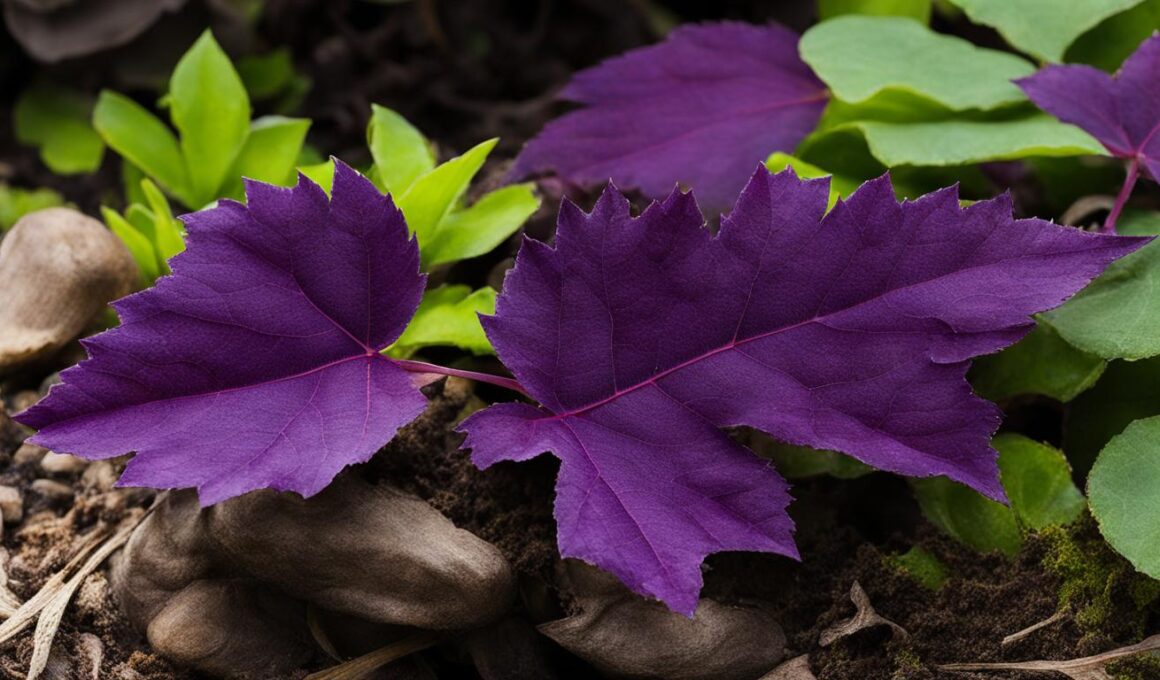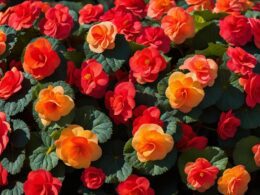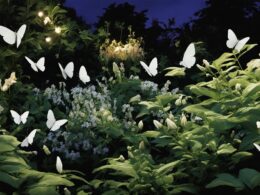Are you looking to add a splash of vibrant color to your garden? Purple leaf plants are the perfect choice! With their rich and eye-catching foliage, they create a stunning visual impact. Whether you’re aiming to identify purple leaf plants, explore plants with purple foliage, or discover colorful foliage plants, we’ve got you covered.
When it comes to purple leaf plant varieties, the options are endless. From deep and dark purples to shades that border on black, these plants offer a variety of colors to choose from. Some popular examples include bugleweed, alternanthera, rex begonias, and coleus. Each of these plants thrives in different growing conditions, allowing you to find the perfect fit for your garden.
Whether your garden enjoys full sun or part shade, there’s a purple leaf plant that will suit your needs. Their versatility makes them a great addition to any garden style or design. So, if you’re ready to bring a burst of color to your outdoor space, let’s dive into the world of purple leaf plants and explore their identification.
Identifying purple leaf plants can be an exciting task. It allows you to unleash your creativity and experiment with different combinations. So, get ready to discover the wonders of purple leaf plants and transform your garden into a colorful oasis.
Purple Leaf Plant Care Tips
To ensure the vibrant foliage of your purple leaf plants remains healthy, it’s essential to provide them with proper care and maintenance. Here are some tips to help you keep your plants thriving:
1. Growing Conditions: Most purple leaf plants prefer full sun to part shade and well-drained soil. Make sure to choose a suitable location in your garden that receives adequate sunlight.
2. Watering: Purple leaf plants need regular watering, especially during dry periods, to prevent the leaves from wilting. Keep the soil consistently moist but avoid overwatering, as it may lead to root rot.
3. Moisture Requirements: Some purple leaf plants, like elephant’s ear, require constant moisture and thrive in wet conditions. If you have such plants in your garden, make sure to provide them with the appropriate level of moisture.
4. Pruning: Proper pruning is crucial for maintaining the overall health and appearance of purple leaf plants. Regularly remove dead or damaged leaves to promote new growth and prevent disease or pest issues.
5. Fertilization: Apply a balanced fertilizer according to the specific needs of your purple leaf plants. This will provide them with essential nutrients to support their growth and vibrant foliage.
6. Temperature Protection: Protect your purple leaf plants from extreme temperatures, such as frost or heatwaves, as they can be sensitive to these conditions. Consider using protective covers or relocating them during temperature extremes.
7. Spacing: Ensure adequate spacing between your purple leaf plants to allow for proper air circulation and prevent overcrowding. This will minimize the risk of diseases and promote optimal growth.
By following these care tips, you can ensure the long-term health and beauty of your purple leaf plants. Take the time to understand the specific needs of each plant variety and adjust your care routine accordingly.
What Are Some Purple Leaf Plants That Have White Flowers?
Some purple leaf plants that have white flowers include the Japanese painted fern and the “identify white flower plant“. These striking plants can add a pop of color to any garden or landscape. With their unique combination of purple foliage and white blossoms, they are sure to stand out in any setting.
Best Uses for Purple Leaf Plants
Purple leaf plants offer a myriad of creative opportunities to enhance your garden and landscaping. With their vibrant and striking foliage, these plants add depth and contrast to flower beds and borders, transforming ordinary spaces into stunning visual displays.
One of the best ways to incorporate purple leaf plants is by using them as ground covers. Plant them densely to create a carpet of color and texture, giving your garden a lush and vibrant look. The rich shades of purple will beautifully complement other plants and flowers, creating a captivating and harmonious landscape.
Another fantastic way to utilize purple leaf plants is in containers. Placing these plants in attractive pots and arranging them on patios, balconies, or outdoor seating areas adds an instant visual interest and allure. Whether you opt for small and compact varieties or larger specimens, the intense hues of purple foliage will lend an enchanting touch to your outdoor spaces.
Furthermore, purple leaf plants are ideal for creating focal points or highlighting specific areas of your garden. Use them strategically to draw attention to key features such as walkways, entrances, or garden sculptures. Their bold colors will act as eye-catching beacons, guiding the viewer’s gaze and creating a sense of intrigue and drama.
Whether your garden style is modern, traditional, or eclectic, there are countless purple leaf plant varieties that can suit your design preferences. From smaller plants like the purple heart (Setcreasea pallida) to larger shrubs like the purple smokebush (Cotinus coggygria), there is a purple leaf plant for every garden style and size. Experiment with different combinations, textures, and placement to create a visually stunning and unforgettable landscape.









